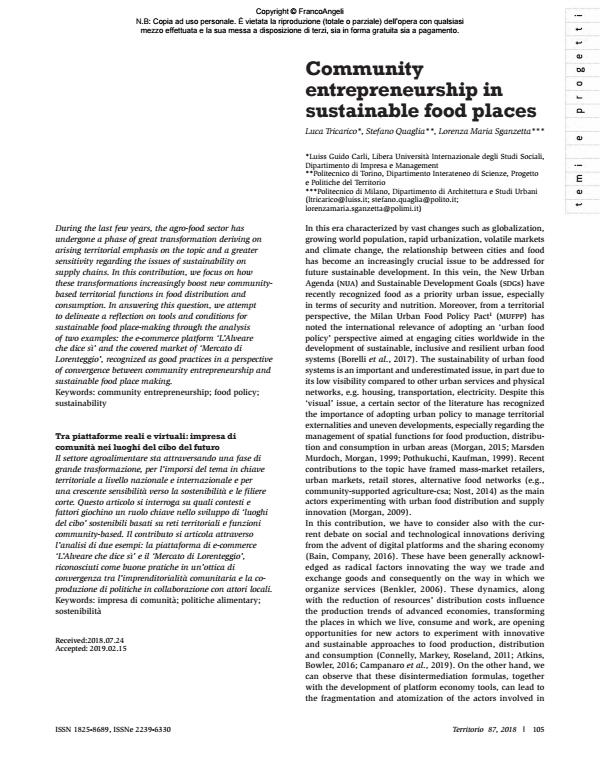Community entrepreneurship in sustainable food places
Titolo Rivista TERRITORIO
Autori/Curatori Luca Tricarico, Stefano Quaglia, Lorenza Maria Sganzetta
Anno di pubblicazione 2019 Fascicolo 2018/87
Lingua Inglese Numero pagine 8 P. 105-112 Dimensione file 361 KB
DOI 10.3280/TR2018-087017
Il DOI è il codice a barre della proprietà intellettuale: per saperne di più
clicca qui
Qui sotto puoi vedere in anteprima la prima pagina di questo articolo.
Se questo articolo ti interessa, lo puoi acquistare (e scaricare in formato pdf) seguendo le facili indicazioni per acquistare il download credit. Acquista Download Credits per scaricare questo Articolo in formato PDF

FrancoAngeli è membro della Publishers International Linking Association, Inc (PILA)associazione indipendente e non profit per facilitare (attraverso i servizi tecnologici implementati da CrossRef.org) l’accesso degli studiosi ai contenuti digitali nelle pubblicazioni professionali e scientifiche
During the last few years, the agro-food sector has undergone a phase of great transformation deriving on arising territorial emphasis on the topic and a greater sensitivity regarding the issues of sustainability on supply chains. In this contribution, we focus on how these transformations increasingly boost new communitybased territorial functions in food distribution and consumption. In answering this question, we attempt to delineate a reflection on tools and conditions for sustainable food place-making through the analysis of two examples: the e-commerce platform ‘L’Alveare che dice sì’ and the covered market of ‘Mercato di Lorenteggio’, recognized as good practices in a perspective of convergence between community entrepreneurship and sustainable food place making.
Il settore agroalimentare sta attraversando una fase di grande trasformazione, per l’imporsi del tema in chiave territoriale a livello nazionale e internazionale e per una crescente sensibilità verso la sostenibilità e le filiere corte. Questo articolo si interroga su quali contesti e fattori giochino un ruolo chiave nello sviluppo di ‘luoghi del cibo’ sostenibili basati su reti territoriali e funzioni community-based. Il contributo si articola attraverso l’analisi di due esempi: la piattaforma di e-commerce ‘L’Alveare che dice sì’ e il ‘Mercato di Lorenteggio’, riconosciuti come buone pratiche in un’ottica di convergenza tra l’imprenditorialità comunitaria e la coproduzione di politiche in collaborazione con attori locali.
Parole chiave:Impresa di comunità; politiche alimentary; sostenibilità
- L'innovazione sociale nelle politiche urbane. Un caso studio nel contesto italiano Luca Tricarico, Rosamaria Bitetti, Maria Isabella Leone, in TERRITORIO 96/2021 pp.108
DOI: 10.3280/TR2021-096010 - The Role of Community Participation in Cross-Sector Social Partnerships Riccardo Maiolini, Pietro Versari, Francesco Rullani, M. May Seitanidi, in Nonprofit and Voluntary Sector Quarterly /2023 pp.1386
DOI: 10.1177/08997640221130696
Luca Tricarico, Stefano Quaglia, Lorenza Maria Sganzetta, Community entrepreneurship in sustainable food places in "TERRITORIO" 87/2018, pp 105-112, DOI: 10.3280/TR2018-087017